Related Research Articles
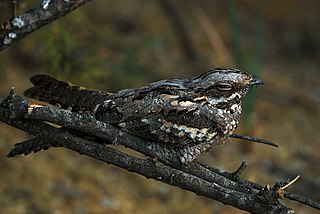
The European nightjar, common goatsucker, Eurasian nightjar or just nightjar, is a crepuscular and nocturnal bird in the nightjar family that breeds across most of Europe and the Palearctic to Mongolia and Northwestern China. The Latin generic name refers to the old myth that the nocturnal nightjar suckled from goats, causing them to cease to give milk. The six subspecies differ clinally, the birds becoming smaller and paler towards the east of the range. All populations are migratory, wintering in sub-Saharan Africa. Their densely patterned grey and brown plumage makes individuals difficult to see in the daytime when they rest on the ground or perch motionless along a branch, although the male shows white patches in the wings and tail as he flies at night.
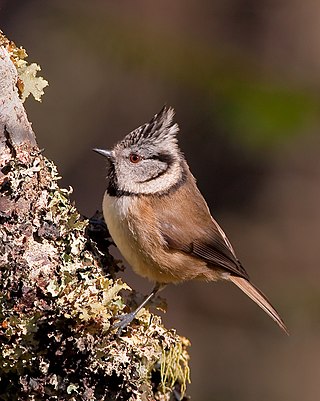
The tits, chickadees, and titmice constitute the Paridae, a large family of small passerine birds which occur mainly in the Northern Hemisphere and Africa. Most were formerly classified in the genus Parus.
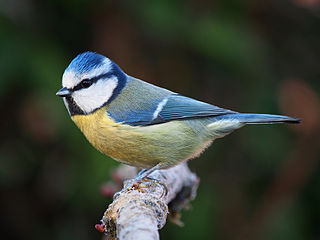
The Eurasian blue tit is a small passerine bird in the tit family, Paridae. It is easily recognisable by its blue and yellow plumage and small size.

The great tit is a passerine bird in the tit family Paridae. It is a widespread and common species throughout Europe, the Middle East, Central Asia and east across the Palearctic to the Amur River, south to parts of North Africa where it is generally resident in any sort of woodland; most great tits do not migrate except in extremely harsh winters. Until 2005 this species was lumped with numerous other subspecies. DNA studies have shown these other subspecies to be distinct from the great tit and these have now been separated as two distinct species, the cinereous tit of southern Asia, and the Japanese tit of East Asia. The great tit remains the most widespread species in the genus Parus.
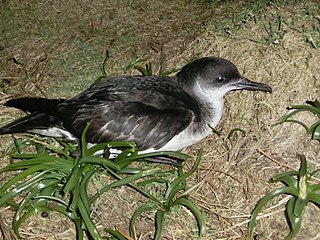
The Manx shearwater is a medium-sized shearwater in the seabird family Procellariidae. The scientific name of this species records a name shift: Manx shearwaters were called Manks puffins in the 17th century. Puffin is an Anglo-Norman word for the cured carcasses of nestling shearwaters. The Atlantic puffin acquired the name much later, possibly because of its similar nesting habits.

Cory's shearwater is a large shearwater in the seabird family Procellariidae. It breeds colonially of rocky islands in the eastern Atlantic. Outside the breeding season it ranges widely in the Atlantic. It was formerly considered to be conspecific with Scopoli's shearwater.

The common murre also called the common guillemot or foolish guillemot,(Uria aalge) is a large auk. It has a circumpolar distribution, occurring in low-Arctic and boreal waters in the North Atlantic and North Pacific. It spends most of its time at sea, only coming to land to breed on rocky cliff shores or islands.

The long-tailed tit, also named long-tailed bushtit, is a common bird found throughout Europe and the Palearctic. The genus name Aegithalos was a term used by Aristotle for some European tits, including the long-tailed tit.

The lesser redpoll is a small passerine bird in the finch family, Fringillidae. It is the smallest, brownest, and most streaked of the redpolls. It is sometimes classified as a subspecies of the common redpoll but has recently been split from that species by most taxonomies including Clements and the British Ornithologists' Union. It is native to Europe and has been introduced to New Zealand. Many birds migrate further south in winter, but the mild climate means that it can be found all year round in much of its range, and may be joined by the other two redpoll species in winter.

David Lambert Lack FRS was a British evolutionary biologist who made contributions to ornithology, ecology, and ethology. His 1947 book, Darwin's Finches, on the finches of the Galapagos Islands was a landmark work as were his other popular science books on Life of the Robin and Swifts in a Tower. He developed what is now known as Lack's Principle which explained the evolution of avian clutch sizes in terms of individual selection as opposed to the competing contemporary idea that they had evolved for the benefit of species. His pioneering life-history studies of the living bird helped in changing the nature of ornithology from what was then a collection-oriented field. He was a longtime director of the Edward Grey Institute of Field Ornithology at the University of Oxford.
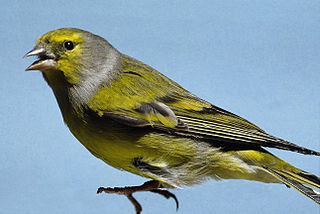
The citril finch, also known as the Alpine citril finch, is a small songbird, a member of the true finch family, Fringillidae. For a long time, this cardueline finch was placed in the genus Serinus, but it is apparently very closely related to the European goldfinch.
Janet Kear was an English ornithologist and conservationist who worked extensively on waterfowl and wrote several major works on ducks. She was the first woman to become president of the British Ornithologists' Union (BOU).

The Iago sparrow, also known as the Cape Verde or rufous-backed sparrow, is a passerine bird of the sparrow family Passeridae. It is endemic to the Cape Verde archipelago, in the eastern Atlantic Ocean near western Africa. Females and young birds have brown plumage with black marks above, and a dull grey underside, and are distinguished from other species of sparrow by their large, distinct supercilium. Males have a brighter underside and bold black and chestnut stripes on their head. At 12.5–13 centimetres (4.9–5.1 in) long, it is a smaller sparrow. This bird's vocalisations are mostly variations on its chirp, which differ somewhat between males and females.

The Italian sparrow, also known as the cisalpine sparrow, is a passerine bird of the sparrow family Passeridae, found in Italy and other parts of the Mediterranean region. In appearance, it is intermediate between the house sparrow, and the Spanish sparrow, a species of the Mediterranean and Central Asia closely related to the house sparrow. The Italian sparrow occurs in northern Italy and neighbouring regions, with intermediates with the house sparrow in a very narrow contact zone in the Alps, a slow gradation in appearance from the Italian to Spanish sparrows across central and southern Italy, and more birds of intermediate appearance in Malta, Crete, and other parts of the Mediterranean.

Cygnus falconeri, the giant swan, is an extinct, very large swan known from Middle Pleistocene-aged deposits from Malta and Sicily. Its dimensions are described as exceeding those of the living mute swan by one-third, which would give a bill-to-tail length of about 190–210 cm (75–83 in). By comparison to the bones of living swans, it can be estimated that it weighed around 16 kg (35 lb) and had a wingspan of about 3 m (9.8 ft). It would have been taller, though not heavier, than the region's dwarf elephants. Due to its size, it may have been flightless. It became extinct before the increase in human activity in the region, so its disappearance is thought to have resulted from extreme climate fluctuations or the arrival of predators and superior competitors. Its bones are exhibited at Għar Dalam museum in Birżebbuġa, Malta.

The mute swan is a species of swan and a member of the waterfowl family Anatidae. It is native to much of Eurosiberia, and the far north of Africa. It is an introduced species in North America, home to the largest populations outside of its native range, with additional smaller introductions in Australasia and southern Africa. The name "mute" derives from it being less vocal than other swan species. Measuring 125 to 160 cm in length, this large swan is wholly white in plumage with an orange beak bordered with black. It is recognizable by its pronounced knob atop the beak, which is larger in males.
Timothy Robert Birkhead is a British ornithologist. He has been Professor of Behaviour and Evolution at the University of Sheffield since 1976.

The Godman-Salvin Medal is a medal of the British Ornithologists' Union awarded "to an individual as a signal honour for distinguished ornithological work." It was instituted in 1919 in the memory of Frederick DuCane Godman and Osbert Salvin.

Scopoli's shearwater is a seabird in the petrel family Procellariidae. It breeds on rocky islands and on steep coasts in the Mediterranean but outside the breeding season it forages in the Atlantic. It is brownish grey above with darker wings and mostly white below. The bill is pale yellow with a dark patch near the tip. The sexes are alike. It was formerly considered to be conspecific with Cory's shearwater.
Ben C. Sheldon is the Luc Hoffmann Chair in Field Ornithology and Director of the Edward Grey Institute of Field Ornithology of the University of Oxford's Department of Zoology. He was Head of the Department of Zoology between 2016 and 2021.
References
- 1 2 3 4 5 6 7 8 Anon (1992). "Perrins, Prof. Christopher Miles" . Who's Who (online Oxford University Press ed.). Oxford: A & C Black. doi:10.1093/ww/9780199540884.013.30593.(Subscription or UK public library membership required.)
- 1 2 3 Perrins, Christopher Miles (1963). Some factors influencing brood-size and populations in tits (DPhil thesis). University of Oxford. OCLC 44835614. EThOS uk.bl.ethos.671392.
- 1 2 Birkhead, Timothy Robert (1976). Breeding biology and survival of guillemots (Uria aalge). ora.ox.ac.uk (DPhil thesis). University of Oxford. OCLC 44837387. EThOS uk.bl.ethos.449886
 .
. - 1 2 Ridley, Matthew White (1983). Mating system of the pheasant (Phasianus colchicus) (DPhil thesis). University of Oxford. OCLC 52225811. EThOS uk.bl.ethos.348151. Archived from the original on 16 July 2022. Retrieved 15 July 2016.
- 1 2 3 4 5 Anon (1997). "Professor Christopher Perrins LVO FRS". London: royalsociety.org. Archived from the original on 17 November 2015. One or more of the preceding sentences incorporates text from the royalsociety.org website where:
"All text published under the heading 'Biography' on Fellow profile pages is available under Creative Commons Attribution 4.0 International License." -- "Royal Society Terms, conditions and policies". Archived from the original on 25 September 2015. Retrieved 9 March 2016.
{{cite web}}: CS1 maint: bot: original URL status unknown (link) - ↑ "Weekend birthdays", The Guardian , p. 52, 10 May 2014
- 1 2 3 4 Perrins, Chris (2015). "Professor Chris Perrins LVO FRS". Oxford: University of Oxford. Archived from the original on 28 March 2015.
- ↑ Christopher Perrins, Professor of Zoology at Oxford University talks about Swan Upping on YouTube
- 1 2 Charmantier, A.; McCleery, R. H.; Cole, L. R.; Perrins, C.; Kruuk, L. E. B.; Sheldon, B. C. (2008). "Adaptive Phenotypic Plasticity in Response to Climate Change in a Wild Bird Population". Science . 320 (5877): 800–803. Bibcode:2008Sci...320..800C. doi:10.1126/science.1157174. PMID 18467590. S2CID 206512427.
- ↑ Charmantier, A.; Perrins, C.; McCleery, R. H.; Sheldon, B. C. (2006). "Quantitative genetics of age at reproduction in wild swans: Support for antagonistic pleiotropy models of senescence". Proceedings of the National Academy of Sciences . 103 (17): 6587–6592. Bibcode:2006PNAS..103.6587C. doi: 10.1073/pnas.0511123103 . PMC 1458927 . PMID 16618935.

- ↑ Mccleery, R. H.; Perrins, C. M.; Wheeler, D.; Groves, S. (2006). "The effect of breeding status on the timing of moult in Mute Swans Cygnus olor". Ibis. 149 (1): 86–90. doi:10.1111/j.1474-919X.2006.00596.x.
- 1 2 Perrins, Chris (2016). "Oxford Alumni: Professor Chris Perrins". Oxford: University of Oxford. Archived from the original on 21 July 2016.
- ↑ Ropert-Coudert, Yan; Guilford, Tim; Freeman, Robin; Boyle, Dave; Dean, Ben; Kirk, Holly; Phillips, Richard; Perrins, Chris (2011). "A Dispersive Migration in the Atlantic Puffin and Its Implications for Migratory Navigation". PLOS ONE . 6 (7): e21336. Bibcode:2011PLoSO...621336G. doi: 10.1371/journal.pone.0021336 . PMC 3140476 . PMID 21799734.

- ↑ Savill, Peter; Perrins, Christopher; Kirby, Keith; Fisher, Nigel (2011). Wytham Woods: Oxford's Ecological Laboratory. Oxford: Oxford University Press. p. 282. doi:10.1093/acprof:osobl/9780199605187.001.0001. ISBN 9780199605187. Archived from the original on 23 August 2016.
- ↑ Dean, B.; Freeman, R.; Kirk, H.; Leonard, K.; Phillips, R. A.; Perrins, C. M.; Guilford, T. (2012). "Behavioural mapping of a pelagic seabird: combining multiple sensors and a hidden Markov model reveals the distribution of at-sea behaviour". Journal of the Royal Society Interface . 10 (78): 20120570. doi:10.1098/rsif.2012.0570. PMC 3565783 . PMID 23034356.

- ↑ Chris Perrins's publications indexed by the Scopus bibliographic database. (subscription required)
- ↑ Perrins, C. M. (2008). "Tits and their caterpillar food supply". Ibis. 133: 49–54. doi: 10.1111/j.1474-919X.1991.tb07668.x . S2CID 84885659.
- ↑ Perrins, C. M. (2008). "Eggs, egg formation and the timing of breeding". Ibis. 138 (1): 2–15. doi:10.1111/j.1474-919X.1996.tb04308.x.
- ↑ Pettifor, R. A.; Perrins, C. M.; McCleery, R. H. (1988). "Individual optimization of clutch size in great tits". Nature. 336 (6195): 160–162. Bibcode:1988Natur.336..160P. doi:10.1038/336160a0. S2CID 4349069.
- ↑ Noordwijk, A.J. Van; McCleery, R.H.; Perrins, C.M. (1995). "Selection for the Timing of Great Tit Breeding in Relation to Caterpillar Growth and Temperature". The Journal of Animal Ecology. 64 (4): 451. doi:10.2307/5648. JSTOR 5648.
- ↑ British Tits (1979) Collins New Naturalist Series ISBN 978-0002195379
- ↑ Encyclopedia of Birds (1985) Christopher M. Perrins and A.L.A. Middleton, Facts on File Inc ISBN 978-0816011506
- ↑ The Mute Swan (1986) Helm Field Guides, Birkhead M. Perrins C. ISBN 978-0709932598